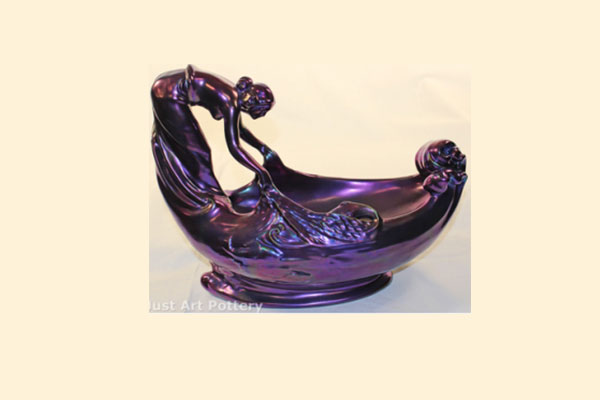Ask any Zsolnay Ceramics collector to describe this European line of art pottery in just one word, and you’ll surely hear  “iridescent”. Initially, this Hungarian family set out to create stoneware that was functional and utilitarian. A decade after being founded in 1853, Vilmos Zsolnay entered the family business and learned how his father’s business worked. Over the course of another decade, Vilmos brought the company to heights his father had never dreamed possible. World fairs and international exhibitions followed and so did the awards. Eosin porcelain became the dominant material and as the company grew, so did the Zsolnay family. Julia Zsolnay, Vilmos’s sister, married and her husband soon joined the business.
“iridescent”. Initially, this Hungarian family set out to create stoneware that was functional and utilitarian. A decade after being founded in 1853, Vilmos Zsolnay entered the family business and learned how his father’s business worked. Over the course of another decade, Vilmos brought the company to heights his father had never dreamed possible. World fairs and international exhibitions followed and so did the awards. Eosin porcelain became the dominant material and as the company grew, so did the Zsolnay family. Julia Zsolnay, Vilmos’s sister, married and her husband soon joined the business.
Even though the family artists had their own distinctions, there’s no denying the seamless look and feel. The pottery, as mentioned, was mostly iridescent in appearance and many of their creations can still be seen in various landmarks and buildings throughout Hungary.
The iridescence is due to a process called “eosin” and it’s a hallmark for many artistic efforts during this time period (at the turn of the century). The eosin works as a glaze and gives it a certain metallic look, but the magic is found in the different colors that are anything but static. Adjust the piece slightly and what was purple becomes red. It’s a lovely presentation and as collectors can attest to, highly sought after.
The Zsolnay Hungarian art pottery centerpiece, shown above, has the eosin glaze and depicts a woman trying to capture fish. It’s a larger piece and is in mint condition. It measures an impressive 11 inches in height and measures 14 inches wide. It’s a beautiful effort that’s quite detailed. This is just one of the Zsolnay Pottery offerings that are available right now. Be sure to explore our complete inventory.
Like many companies, the various wars took their tolls on the company and the Budapest location was bombed. For a while, before being sold, the family tried to re-introduce durable and useable stoneware, but by then, there was just no turning back. The company was sold. In recent years, the family has begun to rebuild the Zsolnay Porcelain Manufacture. Two years ago, it partnered with IKEA. While it may never revert to the true European art pottery company, what we’re left with is an impressive body of work that’s highly sought after and deeply respected around the world.


